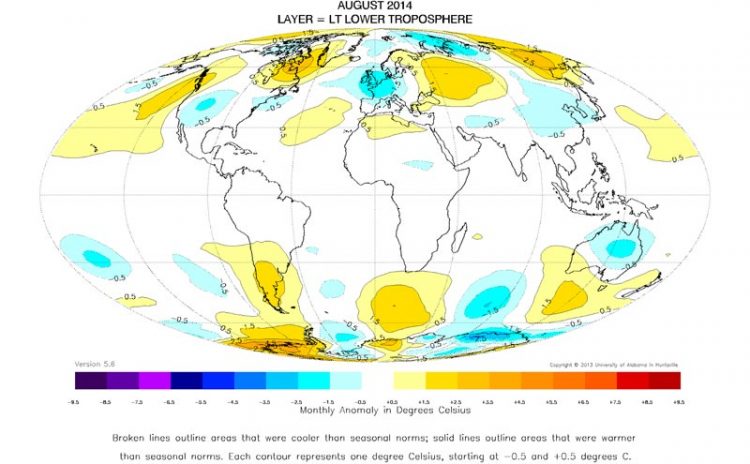Global Temperature Report: August 2014

UAH Aug. 2014 Layer = LT Lower Troposphere
Global climate trend since Nov. 16, 1978: +0.14 C per decade
August temperatures (preliminary)
Global composite temp.: +0.20 C (about 0.36 degrees Fahrenheit) above 30-year average for August.
Northern Hemisphere: +0.24 C (about 0.43 degrees Fahrenheit) above 30-year average for August.
Southern Hemisphere: +0.15 C (about 0.27 degrees Fahrenheit) above 30-year average for August.
Tropics: +0.06 C (about 0.11 degrees Fahrenheit) above 30-year average for August.
July temperatures (revised):
Global Composite: +0.30 C above 30-year average
Northern Hemisphere: +0.29 C above 30-year average
Southern Hemisphere: +0.32 C above 30-year average
Tropics: +0.45 C above 30-year average
(All temperature anomalies are based on a 30-year average (1981-2010) for the month reported.)
Notes on data released Sept. 2, 2014:
Temperatures in the tropics fell to nearly normal values in August, indicating a pause in the buildup to the anticipated El Niño Pacific Ocean warming event for this winter, according to Dr. John Christy, a professor of atmospheric science and director of the Earth System Science Center at The University of Alabama in Huntsville.
Compared to seasonal norms, the coldest place in Earth's atmosphere in August was in the Wilkes Land section of Antarctica, where temperatures were as much as 3.85 C (about 6.93 degrees Fahrenheit) colder than seasonal norms. Compared to seasonal norms, the warmest departure from average in August was also in the Antarctic, just off the coast of West Antarctica by the Amundsen Sea. Temperatures there were as much as 4.83 C (about 8.69 degrees Fahrenheit) warmer than seasonal norms.
Archived color maps of local temperature anomalies are available on-line at:
As part of an ongoing joint project between UAHuntsville, NOAA and NASA, Christy and Dr. Roy Spencer, an ESSC principal scientist, use data gathered by advanced microwave sounding units on NOAA and NASA satellites to get accurate temperature readings for almost all regions of the Earth. This includes remote desert, ocean and rain forest areas where reliable climate data are not otherwise available.
The satellite-based instruments measure the temperature of the atmosphere from the surface up to an altitude of about eight kilometers above sea level. Once the monthly temperature data is collected and processed, it is placed in a “public” computer file for immediate access by atmospheric scientists in the U.S. and abroad.
Neither Christy nor Spencer receives any research support or funding from oil, coal or industrial companies or organizations, or from any private or special interest groups. All of their climate research funding comes from federal and state grants or contracts.
Contact Information
Jim Steele
Research Writer/Editor
jim.steele@uah.edu
Phone: 256-824-2772
Media Contact
All latest news from the category: Earth Sciences
Earth Sciences (also referred to as Geosciences), which deals with basic issues surrounding our planet, plays a vital role in the area of energy and raw materials supply.
Earth Sciences comprises subjects such as geology, geography, geological informatics, paleontology, mineralogy, petrography, crystallography, geophysics, geodesy, glaciology, cartography, photogrammetry, meteorology and seismology, early-warning systems, earthquake research and polar research.
Newest articles

Superradiant atoms could push the boundaries of how precisely time can be measured
Superradiant atoms can help us measure time more precisely than ever. In a new study, researchers from the University of Copenhagen present a new method for measuring the time interval,…

Ion thermoelectric conversion devices for near room temperature
The electrode sheet of the thermoelectric device consists of ionic hydrogel, which is sandwiched between the electrodes to form, and the Prussian blue on the electrode undergoes a redox reaction…

Zap Energy achieves 37-million-degree temperatures in a compact device
New publication reports record electron temperatures for a small-scale, sheared-flow-stabilized Z-pinch fusion device. In the nine decades since humans first produced fusion reactions, only a few fusion technologies have demonstrated…





















